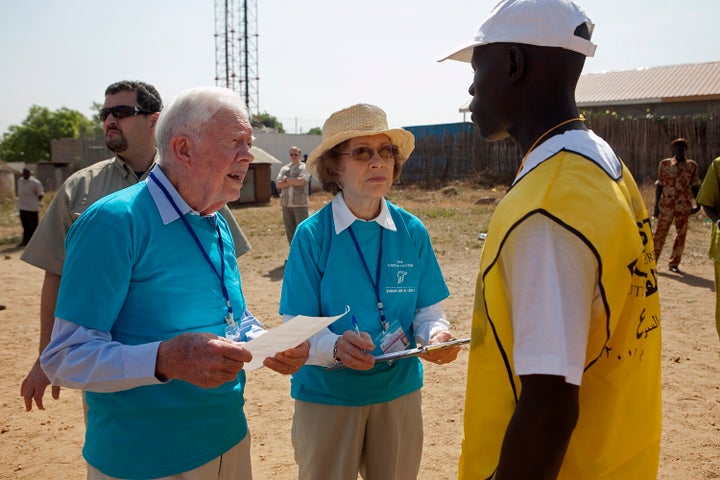
Whenever Jimmy Carter makes a statement, opinions fly.
Yet it wasn't the former U.S. President's political views that had a crowd of students and parents gasping during his speech at an Atlanta private school February 17. It was his talk of a horrific creature known as Guinea Worm that elicited dropped jaws from the audience. As Carter described the painful parasitic illness with an anecdote about an African woman who had a 3-foot-long worm exit her body through her breast's nipple (the disease is contracted when someone ingests water infected with the worm's eggs), much of the crowd couldn't believe that such a malady still exists on earth.
Guinea Worm's gruesomeness dates back to Biblical times, but could also make great subject matter for a modern-day video game (animated characters wielding water filters and larvicide); a new documentary about the battle against the disease, Foul Water, Fiery Serpent, should bring mainstream attention to the more than two-decade journey to get rid of it.
(Warning: graphic video.)
Thanks to the work of The Carter Center and its partners, Guinea Worm is soon expected to follow Small Pox to become the second human disease ever eradicated. Although it remains in Sudan, Mali, and Ethiopia, Guinea Worm has been reduced by more than 99 percent since 1986 -- from 3.5 million cases in 20 countries when The Carter Center first began its campaign, to around 1800 cases today. You can read all about the scientific stuff in the New York Times or in a report by the World Health Organization. What I want to tell you has less to do with the statistics and more to do with the work of the unsung heroes who are the true "worm slayers" and disease fighters in some of the most remote places on earth.
Jimmy Carter has long been one of my personal heroes -- a Christian -- who, since leaving the office of U.S. President in January, 1981, would rather go where he wants to go and do what he wants to do than be restricted by traditional norms and political expectations. Already outspoken about human rights when he and his wife Rosalynn founded The Carter Center in 1982, it would make sense that the pair would create the Center's core values around alleviating human suffering -- hence the tagline, "Waging Peace. Fighting Disease. Building Hope."
Not until you dig into what The Carter Center actually does (including election monitoring, conflict resolution, and various health programs) though, do you realize that President Carter is always the first to pass the recognition on to his staff on the ground (an adventurous, determined and immensely educated crew -- someone should make a reality show about them -- such as 33-year-old David Stobbelaar, who leads 180 field officers and 9000 volunteers in The Carter Center's final frontier battle against Guinea Worm in Sudan, where roads are scarce and unrest is common). And, of course, to the villagers who work to overcome diseases, and to leaders such as former Nigeria Head of State General Yakubu Gowon, who helped make the work to rid his country of Guinea Worm possible.
After his school speech on Feb. 17, I joined President Carter at The Carter Center later that day for a press conference and the Guinea Worm Eradication Ceremony, where both Nigeria and Niger were honored for reducing their countries' reported infection rates to zero. Part of the reason the Center holds the ceremony (this was the fourth in a decade) is to fortify morale for the work yet to be done.
"It's a single disease, but the benefits of the Guinea Worm campaign are many-fold," said Donald Hopkins, Vice President for Health Programs at The Carter Center. Among them, Hopkins said, are the effects that remain once Guinea Worm has been eradicated in a particular village -- including improvements in the water supply, people who have received training, health practices, and the ability for children to go to school.
The Guinea Worm program, President Carter told me, has also provided valuable lessons about human capacity for change.
"The main lesson I've learned in the whole process [of Guinea Worm eradication] is that we underestimate the capability of people -- if given a chance -- to improve their own lives," he said. "I have great confidence in the future in continuing, along with many other NGOs and governments, to make progress with other diseases. I think the proof that we've been successful with Guinea Worm will be not only an inspiration to others, but a confidence building measure that something very difficult can be done."
To fight disease is one thing; to fight and win is another. And The Carter Center's work proves that you don't have to be a former U.S. President to make it happen. Just being a fighter is enough.
To learn more about Guinea Worm, and all of the Carter Center's Health Programs, click here.
